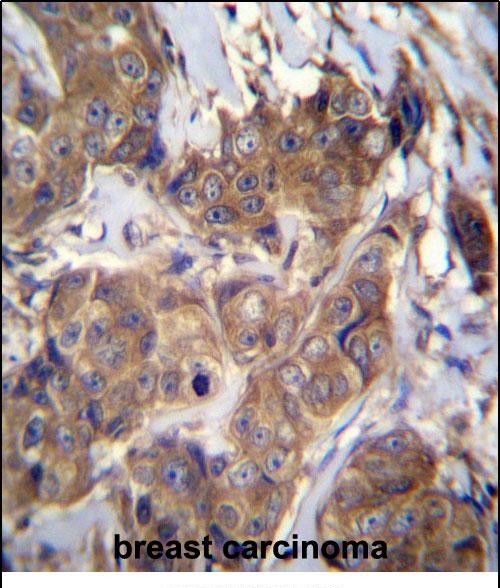ATP6V1B1 Antibody (C-term)
Affinity Purified Rabbit Polyclonal Antibody (Pab)
- 产品详情
- 实验流程
- 背景知识
Application
| WB, IHC-P, E |
|---|---|
| Primary Accession | P15313 |
| Other Accession | NP_001683.2 |
| Reactivity | Human |
| Host | Rabbit |
| Clonality | Polyclonal |
| Isotype | Rabbit IgG |
| Calculated MW | 56833 Da |
| Antigen Region | 472-501 aa |
| Gene ID | 525 |
|---|---|
| Other Names | V-type proton ATPase subunit B, kidney isoform, V-ATPase subunit B 1, Endomembrane proton pump 58 kDa subunit, Vacuolar proton pump subunit B 1, ATP6V1B1, ATP6B1, VATB, VPP3 |
| Target/Specificity | This ATP6V1B1 antibody is generated from rabbits immunized with a KLH conjugated synthetic peptide between 472-501 amino acids from the C-terminal region of human ATP6V1B1. |
| Dilution | WB~~1:1000 IHC-P~~1:100~500 E~~Use at an assay dependent concentration. |
| Format | Purified polyclonal antibody supplied in PBS with 0.09% (W/V) sodium azide. This antibody is purified through a protein A column, followed by peptide affinity purification. |
| Storage | Maintain refrigerated at 2-8°C for up to 2 weeks. For long term storage store at -20°C in small aliquots to prevent freeze-thaw cycles. |
| Precautions | ATP6V1B1 Antibody (C-term) is for research use only and not for use in diagnostic or therapeutic procedures. |
| Name | ATP6V1B1 |
|---|---|
| Synonyms | ATP6B1, VATB, VPP3 |
| Function | Non-catalytic subunit of the V1 complex of vacuolar(H+)- ATPase (V-ATPase), a multisubunit enzyme composed of a peripheral complex (V1) that hydrolyzes ATP and a membrane integral complex (V0) that translocates protons (PubMed:16769747). V-ATPase is responsible for acidifying and maintaining the pH of intracellular compartments and in some cell types, is targeted to the plasma membrane, where it is responsible for acidifying the extracellular environment (PubMed:32001091). Essential for the proper assembly and activity of V- ATPase (PubMed:16769747). In renal intercalated cells, mediates secretion of protons (H+) into the urine thereby ensuring correct urinary acidification (PubMed:16769747). Required for optimal olfactory function by mediating the acidification of the nasal olfactory epithelium (By similarity). |
| Cellular Location | Apical cell membrane. Basolateral cell membrane {ECO:0000250|UniProtKB:Q91YH6} |
| Tissue Location | Kidney; localizes to early distal nephron, encompassing thick ascending limbs and distal convoluted tubules (at protein level) (PubMed:16769747, PubMed:29993276). Expressed in the cochlea and endolymphatic sac (PubMed:9916796) |
For Research Use Only. Not For Use In Diagnostic Procedures.
Provided below are standard protocols that you may find useful for product applications.
BACKGROUND
This gene encodes a component of vacuolar ATPase (V-ATPase), a multisubunit enzyme that mediates acidification of eukaryotic intracellular organelles. V-ATPase dependent organelle acidification is necessary for such intracellular processes as protein sorting, zymogen activation, receptor-mediated endocytosis, and synaptic vesicle proton gradient generation. V-ATPase is composed of a cytosolic V1 domain and a transmembrane V0 domain. The V1 domain consists of three A and three B subunits, two G subunits plus the C, D, E, F, and H subunits. The V1 domain contains the ATP catalytic site. The V0 domain consists of five different subunits: a, c, c', c'', and d. Additional isoforms of many of the V1 and V0 subunit proteins are encoded by multiple genes or alternatively spliced transcript variants. This encoded protein is one of two V1 domain B subunit isoforms and is found in the kidney. Mutations in this gene cause distal renal tubular acidosis associated with sensorineural deafness. [provided by RefSeq].
REFERENCES
Bailey, S.D., et al. Diabetes Care 33(10):2250-2253(2010)
Sharifian, M., et al. Iran J Kidney Dis 4(3):202-206(2010)
Talmud, P.J., et al. Am. J. Hum. Genet. 85(5):628-642(2009)
Andreucci, E., et al. Pediatr. Nephrol. 24(11):2147-2153(2009)
Sethi, S.K., et al. Indian Pediatr 46(5):425-427(2009)
终于等到您。ABCEPTA(百远生物)抗体产品。
点击下方“我要评价 ”按钮提交您的反馈信息,您的反馈和评价是我们最宝贵的财富之一,
我们将在1-3个工作日内处理您的反馈信息。
如有疑问,联系:0512-88856768 tech-china@abcepta.com.























 癌症的基本特征包括细胞增殖、血管生成、迁移、凋亡逃避机制和细胞永生等。找到癌症发生过程中这些通路的关键标记物和对应的抗体用于检测至关重要。
癌症的基本特征包括细胞增殖、血管生成、迁移、凋亡逃避机制和细胞永生等。找到癌症发生过程中这些通路的关键标记物和对应的抗体用于检测至关重要。 为您推荐一个泛素化位点预测神器——泛素化分析工具,可以为您的蛋白的泛素化位点作出预测和评分。
为您推荐一个泛素化位点预测神器——泛素化分析工具,可以为您的蛋白的泛素化位点作出预测和评分。 细胞自噬受体图形绘图工具为你的蛋白的细胞受体结合位点作出预测和评分,识别结合到自噬通路中的蛋白是非常重要的,便于让我们理解自噬在正常生理、病理过程中的作用,如发育、细胞分化、神经退化性疾病、压力条件下、感染和癌症。
细胞自噬受体图形绘图工具为你的蛋白的细胞受体结合位点作出预测和评分,识别结合到自噬通路中的蛋白是非常重要的,便于让我们理解自噬在正常生理、病理过程中的作用,如发育、细胞分化、神经退化性疾病、压力条件下、感染和癌症。







